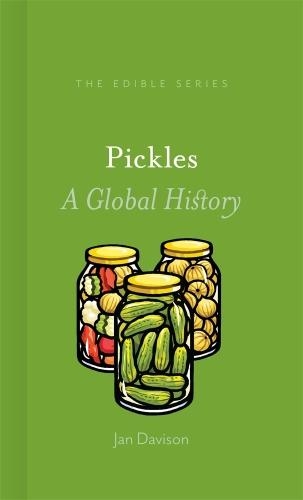
Pickles: A Global History
(Hardback)
Publishing Details
Pickles: A Global History
By (Author) Jan Davison
Reaktion Books
Reaktion Books
18th June 2018
11th June 2018
United Kingdom
Classifications
General
Non Fiction
Cookery: preserving and freezing
641.462
Physical Properties
Hardback
176
Width 120mm, Height 197mm
Description
Pickles are a global food: from the fiery kimchi of Korea and America's dill pickles to the spicy achar of India, the ceviche of Latin America and Europe's sauerkraut, brined herrings and chutneys. Across continents and throughout history, pickling has been relied upon to preserve foods and add to their flavour. They are a cherished food of the elite as well as a staple of the masses, and have acquired a new significance in these health-conscious times: traditionally fermented pickles are probiotic and possess anti-ageing and anti-cancer properties, while pickle juice prevents muscle cramps in athletes and reduces sugar spikes in diabetics. It also cures hangovers.
In Pickles, Jan Davison explores the cultural and gastronomic importance of pickles from the earliest civilizations to the twenty-first century. Discover the art of pickling mastered by the ancient Chinese, find out how the astronaut Ko San took pickled cabbage into space in 2008, learn how the Japanese pickle the deadly pufferfish, and uncover the pickling provenance of that most popular of condiments, tomato ketchup. In this globe-trotting book, Davison discovers how pickles have been omnipresent in our common quest not only to conserve, but to create foods with relish.
Reviews
"To me, a pedant and a purist, a pickle by rights ought to have gone through a proper fermentation. It might have been pasteurized afterwards and bottled, but at some stage it needs to have supported microbial activity. And yet, I don't think of kombucha as pickled tea or yogurt as pickled milk. Maybe that's because they aren't salted. Just being boiled in vinegar or soaked in brine doesn't qualify either, for me. Luckily Davison, author of Pickles: A Global History, has a much more open mind, which is great, because I learned a lot from her little book."--Jeremy Cherfas "Eat This Podcast"
"Pickles aren't simple, or so one learns after consuming just a few pages of Pickles. . . . There are quick pickles, pickle pickles and fermented pickles, not to mention dry salting and dry pickling with soybean paste or rice mold, ketchup, hot sauce--you get the idea. The fundamentals are simple: When the pH drops below 4.6, the acidic environment 'prevents the growth of food-spoiling microorganisms and eliminates certain food toxins and pathogens.' In other words, pickling preserves. And as with most cured foods, the results taste great, too. Pickles were common 4,000 years ago in Mesopotamia. Romans pickled whole fried fish in hot vinegar. The range of pickled foods extends from mushrooms in Russia, locusts in Persia and herring in Holland to bananas in the West Indies, lemons in North Africa and feta in Greece. In Japan, they quick-pickle chrysanthemums as a condiment. Who knew"--Christopher Kimball "Christopher Kimball's Milk Street Magazine"
Author Bio
Jan Davison lives and works in London. Her first book, English Sausages (2015), explored the little-known culinary history of England's sausages and puddings.
